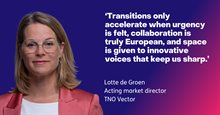How Draghi Steers the New European Commission
In early September, the impressive report "The Future of European Competitiveness" by former ECB President and Italian Prime Minister Mario Draghi was published. His general analysis – the EU economy's innovation capacity and productivity development are increasingly lagging behind the US and China – was received as a wake-up call. His main recommendations – such as the need for €800 billion in additional investments and a new, coordinated industrial policy – made headlines in all member states. The alarming report was handed over to Ursula von der Leyen, the current President of the European Commission (EC), who is running for her second term until 2029. The content of Draghi's report is interesting, but more important for its expected policy impact is that Von der Leyen explicitly instructed her new team of Commissioners to boost European competitiveness a week later.
Three New Portfolios within the EC
"Draghi" is prominently featured in her mission letters for the next five years to the Commissioners. There are three new portfolios for the Executive Vice Presidents, clearly inspired by his ideas. Ribera Rodríquez becomes Executive Vice President for "Clean, Fair, and Competitive Transition"; Henna Virkkunen for "Tech Sovereignty, Security, and Democracy"; and Stéphane Séjourne for "Prosperity and Industrial Strategy". While the focus of the EC 2019-2024 was on being ready for the digital age, an economy that works for people, and achieving the Green Deal and a climate-neutral continent, the priorities for 2024-2029 shift to clean tech, competitiveness, sovereignty, security, and industrial policy.
Far-reaching Proposals for a New Economy
What can we expect from the new European Commission? Reading the mission letters, we can anticipate several far-reaching proposals.
The EC wants to pursue a more active industrial policy, partly in response to the Inflation Reduction Act in the US, which attracts European companies with funds and tax benefits, and the rapidly emerging conquest of the European market by Chinese companies receiving state aid. They want a Clean Industrial Deal with adjustments to EU state aid rules, allowing for more public support to accelerate the energy transition, decarbonize industry, and ensure sufficient production capacity for clean tech. A specific task is to lower energy prices in the EU for businesses, as electricity prices are currently 2 to 3 times higher than in the US and gas prices 4 to 5 times higher. This price difference is mainly due to Europe's scarcer natural resources, but also due to fundamental shortcomings in the joint energy market, such as poorly connected energy infrastructure between member states, different and conflicting national policy regimes, and very limited cross-border competition between energy companies.
Additionally, the EC will review competition policy for horizontal mergers – read: merging (inter)national competitors – because there is a geopolitical need for European companies to operate on a larger scale, have more investment power and willingness, and thus act more resiliently, efficiently, and innovatively on the world stage. Draghi calls these the European champions necessary to compete with American and Asian giants. Besides this relaxation of competition policy, the EC wants to strengthen other parts to better support European companies in scaling up within the EU and beyond, and to more powerfully protect promising, innovative startups and scaleups against killer acquisitions. This is a policy shift: EU competition rules will gain new power-forming and protective functions.
The EC also wants to establish a European Competitiveness Fund (ECF) by bundling existing funds, to quickly organize financing for Important Projects of Common Interest (IPCEIs) for the most strategic sectors and technologies, helped by the relaxed state aid rules. The EU needs to scale up and protect these projects faster in the geopolitical struggle with the US and China. European public procurement rules will also be adjusted to ensure a certain supply of vital technologies, products, and services, and to ensure that European production in strategic sectors and technologies continues. Besides this strategic support for domestic businesses in the internal market, the Commission will more forcefully and compellingly apply the Foreign Subsidies Regulation (FSR). The FSR, which came into force last year, gives the EC the ability to tackle internal market distortions caused by foreign subsidies to companies, for example by forcing subsidized assets to be sold or giving competitors access to subsidized infrastructure. This should ensure a level playing field with foreign companies in the European internal market, in line with the EC's proposal earlier this month for higher tariffs on Chinese electric cars (in Dutch).
New, Coordinated European Industrial Strategy for Innovation
This upcoming EC wants to lead the EU into a modern innovation era with a new, coordinated industrial strategy. The core of this: member states must invest more, coordinate, and innovate, and more actively and powerfully use the opportunities of the joint internal market and external economic policy. This shift was also seen in the Letta report on the future of the internal market: the belief is that guaranteeing the four classical freedoms of persons, goods, services, and capital is no longer sufficient. On Draghi's recommendation, the Commission wants to develop a Competitiveness Coordination Tool through which member states will coordinate investment and policy choices, focusing on clean tech, decarbonization, and incentivizing investment. Brussels also wants to conclude an Industrial Decarbonisation Accelerator Act to create leading markets in the development, production, and adoption of clean tech in industry, with accelerated permitting procedures. Additionally, the competitiveness of the defense industry will be targeted, with improvements to the internal market, stimulation of innovation, and increased coordinated public and private investments. The EC will work on a European Defence Union.
Extra Focus on Digital Innovation in the EU
Digital innovation rightly receives much attention and extra policy focus. The EC will look at how digital technologies and AI opportunities can be better utilized, which is essential for increasing productivity in the EU. Brussels wants AI startups and industries to have access to supercomputing capacity and, together with member states, industry, and social partners, will develop an Apply AI Strategy to improve the use of AI in industry and public services. The functioning of the (future) internal European digital market – like the energy market – must also be significantly improved to increase competitiveness. The Commission is therefore aiming for a Digital Networks Act, a European Data Union Strategy, and an EU Cloud Policy: rules and regulations to harmonize, simplify, and connect. Finally, European cybersecurity standards must be raised and harmonized.
As the EU currently lags significantly behind the US in big tech, the EC primarily wants to increase activities and investments in "emerging" technologies such as supercomputing, semiconductors (chips), the Internet of Things, genomics, quantum computing, and space tech. Here, larger opportunities seem to exist to lead the way in the future, provided they are coordinated. For example, Brussels is now stimulating the development of eight large quantum computers, paying half the costs, with one to be located in Amsterdam at the national supercomputer Snellius. For chips, they will analyze where the strategic segments, innovation potential, and material production opportunities lie, and there will be an EU long-term plan for quantum chips. The Commission wants to focus on future technologies, their economic value, and greater strategic autonomy: much attention will therefore be given to reducing dependencies on critical raw materials and materials from non-EU countries. Hence, an EU Critical Raw Materials Platform will be established. The new EC also wants to launch a Circular Economy Act to create market demand for secondary raw materials and organize a single internal European market for waste, which is also necessary to start reusing critical raw materials and materials.
Europe Will Be Built Through Crises
It is so clear how Draghi is steering the new European Commission, at the request of Von der Leyen. The Commissioners seem set to come up with far-reaching proposals on clean tech, competitiveness, sovereignty, security, and industrial policy over the next five years.
A point of attention for the Netherlands is that we have more of a growing high-tech industry – think of companies like ASML, NXP, or VDL, which make specialized production tools that play increasingly important roles in international value chains – than a green tech industry. Indeed, also to produce green tech, but not exclusively. However, the expanding Dutch high-tech industry has similar problems to the green tech industry that Draghi focuses on, namely that the raw materials for production also predominantly come from China, creating dependencies and vulnerabilities.
The main omission in the mission letters is: how do we get the money? That €800 billion in additional investments will not come solely from the market. While Draghi clearly expresses his support for structural joint debt issuance by EU member states to finance part of the necessary public investments in innovation and infrastructure and strengthen the European capital markets union, this politically sensitive idea understandably does not return. Ultimately, member states will still have to repay joint debt issuance, and national political support for this remains limited. For the Netherlands, it is true that we are sufficiently creditworthy to attract capital ourselves to achieve the goal of investing 3% of GDP in R&D – if we really wanted to. Additionally, we have several private investors such as venture capital, banks, insurers, and pension funds, but they invest only sparingly in the Netherlands itself. There is still policy gain to be made here. Lagging investments are also simply a result of low return expectations, partly because entrepreneurship, valorization, and productivity improvement in the EU and the Netherlands received relatively less attention (or still do) compared to regulating the qualitative effects of innovation or its application. At the European and national levels, there is still room for solutions here.
A major uncertainty is, of course, to what extent Germany and France follow the analysis in the report "The Future of European Competitiveness" and – above all – to what extent they will support the new EC's proposals. While France traditionally – especially under President Macron – has a more positive attitude towards central industrial policy and European investments, Germany is opposed to this. But now that the German economy (in Dutch) and automotive industry (in Dutch) are in very difficult times, and Chancellor Scholz has announced a new industrial policy (in Dutch), things could change. There are similarities with 2020, when the EC launched the EU recovery fund during the corona crisis, and France and Germany suddenly turned out to be supporters, to the great surprise of the Netherlands.
"Europe will be built through crises," predicted Jean Monet, one of the founders of the EU. This proves true time and again. And Draghi knows this.



